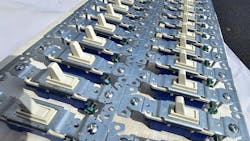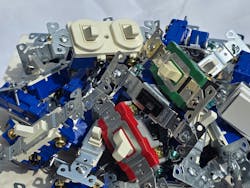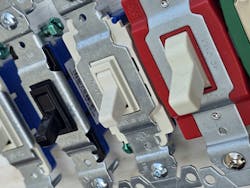Note: This article references the 2017 NEC because the Philadelphia area — the jurisdiction where this author teaches and works— is still operating under that version of the Code.
Electrical switches are essential to operating and controlling motors, luminaires, and appliances used daily in residential, commercial, and industrial applications. The “flush-mounted switch” was patented on July 17, 1917 by William J. Newton from Lynbrook, N.Y. — 20 years after the first publication of the NEC. Article 404 covers the provisions for selecting, replacing, and installing “General Use” switching devices and circuit breakers (toggle and knife switches) used to connect or disconnect the conducting path in an electrical circuit operating at 1,000V and below unless specifically referenced elsewhere in the NEC for higher voltages.
As an electrical apprentice, it’s critical to understand all facets of the Code. Although switches are obviously a simple device, the NEC guidelines may not be quite as straightforward as you might think, depending on the application. So let’s take a look at what applying the Code requirements in this area entails.
Everyday stuff
Chapter 4 of the NEC covers “Equipment for General Use.” This means common stuff you see every day, such as receptacles, transformers, control circuits, and, of course, switches. Electricians use this essential chapter of the NEC daily for the “repair stage” of an electrical project. Article 404 covers switches used for simple, specific, and complex applications, including:
- Surface or flush-mounted switches
- Switches installed in damp and wet locations
- Switches used to control loads from single or multiple locations
- Basic electrical switches (e.g., snap, toggle type, timer, and rocker switches)
- Sophisticated switches (e.g., smart electronic switches, occupancy sensors, and wireless remote switches)
Installing 3- and 4-way switches
Here are a few handy tips to remember when you’re on a job site that relate to Art. 404:
- Three-way and 4-way switches shall be wired so that all the wiring or switching is done on the ungrounded circuit conductor [Sec. 404.2(A) Switch Connections].
- Where multiple switch locations control the same lighting load such that the entire floor area of the room or space is visible from the single or combined switch locations, the grounded circuit conductor shall only be required at one location [Sec. 404.2(C)].
- Where in metal raceways or metal-armored cables, wiring between switches and outlets shall be in accordance with Sec. 300.20(A) [Sec. 404.2(A)].
- Switch loops shall not require a grounded conductor [Sec. 404.2(A) Exception].
Switches controlling lighting loads
Are switches that control lighting loads required to have a neutral conductor present?
A grounded (neutral) conductor shall not be required to be installed at lighting switch locations under any of the following conditions [Sec. 404.2(C)]:
- Where conductors enter the box enclosing the switch through a raceway, provided that the raceway is large enough for all contained conductors, including a grounded conductor.
- Where the box enclosing the switch is accessible for the installation of an additional or replacement cable without removing finish materials.
- Where snap switches with integral enclosures comply with Sec. 300.15(E).
- Where lighting in the area is controlled by automatic means.
- Where a switch controls a receptacle load.
Additional rules about neutral conductor requirements at switches
When working with switches, also remember:
- The grounded conductor shall be extended to any switch location “as necessary” and shall be connected to switching devices that require line-to-neutral voltage to operate the electronics of the switch in the standby mode and shall meet the requirements of Sec. 404.22(C).
- The grounded circuit conductor for the controlled lighting circuit shall be installed where switches control lighting loads supplied by a grounded general-purpose branch circuit serving bathrooms, hallways, stairways, or rooms suitable for human habitation or occupancy as defined in the applicable building code [Sec. 404.2(C)].
Here’s an Exception: The connection requirement shall become effective on January 1, 2020. It shall not apply to replacement or retrofit switches installed in locations prior to local adoption of Sec. 404.2(C) and where the grounded conductor cannot be extended without removing finish materials.
- The number of electronic lighting control switches on a branch circuit shall not exceed five, and the number connected to any feeder on the load side of a system or main bonding jumper shall not exceed 25.
- To comply with Sec. 200.2(B), a neutral busbar, with a main or system bonding jumper connected, shall not be limited to the number of electronic lighting control switches connected.
Remember this Informational Note: The provision for a (future) grounded conductor is to complete a circuit path for electronic lighting control devices.
Circuit breakers used as switches
- A hand-operable circuit breaker equipped with a lever or handle, or a power-operated circuit breaker capable of being opened by hand in the event of a power failure, shall be permitted to serve as a switch if it has the required number of poles [Sec. 404.11].
- Switches or circuit breakers shall not disconnect the grounded conductor of a circuit [Sec. 404.2(B)].
- A switch or circuit breaker shall be permitted to disconnect a grounded circuit conductor where all circuit conductors are disconnected simultaneously or where the device is arranged so that the grounded conductor cannot be disconnected until all the ungrounded conductors of the circuit have been disconnected [Exception 404.2(B)].
- All switches and circuit breakers used as switches shall be located so that they may be operated from a readily accessible place. They shall be installed such that the center of the grip of the operating handle of the switch or circuit breaker — when in its highest position — is not more than 2.0 m (6 ft, 7 in.) above the floor or working platform [Sec. 404.8(A)].
- On busway installations, fused switches and circuit breakers shall be permitted to be located at the same level as the busway. Suitable means shall be provided to operate the handle of the device from the floor [Sec. 404.8(A) Exception No. 1].
- Switches and circuit breakers installed adjacent to motors, appliances, or other equipment they supply shall be permitted to be located higher than 2.0 m (6 ft, 7 in.) and accessible by portable means [Sec. 404.8(A) Exception No. 2].
Switches installed in damp or wet locations
- Switches shall not be installed within tubs or shower spaces unless installed as part of a listed tub or shower assembly [Sec. 404.4(C)].
- A surface-mounted switch or circuit breaker shall be enclosed in a weatherproof enclosure or cabinet that complies with Sec. 312.2 [Sec. 404.4(A)].
- A flush-mounted switch or circuit breaker shall be equipped with a weatherproof cover [Sec. 404.4(B)].
Follow my column for more tips on applying electric basics concepts in the field, navigating the NEC, preparing for exams, and understanding how to apply Code guidelines in the field. Past columns include Everyday Instructions for Electricians, The Apprentices Guide to Special Equipment, The Apprentice’s Intro Guide to Motors, The Apprentice’s Guide to Service Entrance Cable, The Apprentice’s Guide to NEC Art. 382, The Apprentice’s Guide to Article 625, The Apprentice’s Guide to NEC Art. 550 , The Apprentice’s Guide to Informative Annex C, and The Apprentice’s Guide to Success in the Electrical Construction Industry. For more information on why a structured approach is so important to navigating the NEC and how to put its requirements into practice in real-world settings, read “The NEC for Newbies.”
About the Author
Harold De Loach
De Loach is the Director of Education and Training for the Leaders of Electrical License Preparation courses for Philadelphia and The Lehigh Valley (www.necprepclass.com). He is the founder and Director of The Academy of Industrial Arts L.L.C. (www.taia-school.com), a customized electrician training program that provides entry-level electrician training courses, electrical safety classes and customized electrical construction courses. He is trained by the National Center for Construction Education and Research (NCCER). He is a member of The National Society of Collegiate Scholars, the Independent Association of Electrical Inspectors, the Electrical Association of Philadelphia, and the Better Business Bureau.
His level of knowledge affords him to teach entry, intermediate, and master level electricians. Armed with more than 20 years of experience in the electrical, general construction, and real estate development industry, he offers his students and clients several unique skill sets. He has worked as the Head Craft Instructor and Assistant Director of Education at the Apprenticeship Training Center (affectionately known as The ABC School) in Harleysville Pennsylvania for Associated Builders and Contractors (The South-Eastern Pa. Chapter). Prior to Joining ABC, he directed a work-readiness (Re-Entry) Construction Technology program within The Philadelphia Prison System and as an Electrical Technician Program instructor at Kaplan Career Institute (Formerly Thompson institute) in Center City Philadelphia and Franklin Mills. He is available for consultation, private tutoring, speaking engagements, or strategic partnerships that can bolster the number of new electricians entering the industry.



